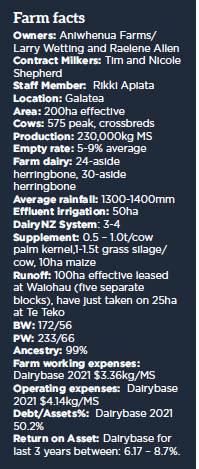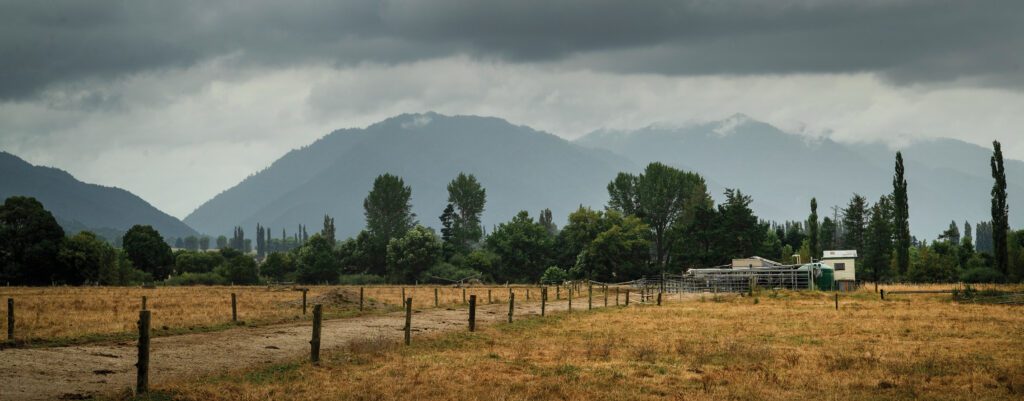A foot in the door
Galatea is a region entrenched in dairy farm progression. Farm owners Larry Wetting and Raelene Allen are keen to offer the same opportunities that helped them to farm ownership. Sheryl Haitana reports.

Galatea is a region entrenched in dairy farm progression. Farm owners Larry Wetting and Raelene Allen are keen to offer the same opportunities that helped them to farm ownership. Sheryl Haitana reports.
Getting your foot in the door as a contract milker, sharemilker or farm owner can often take somebody opening that door for you.
Larry Wetting’s first sharemilking job was in the Galatea valley in 2000 for the Edelsten family farm at Lake Aniwhenua. The third bank he approached finally said yes to lending him the money and three of Larry’s friends also kindly helped him with lease cows to make up numbers in his first year.
“Ann Edelsten and her partner Ross Davies have a wonderful history of hiring and supporting first-time sharemilkers so it was a great start on the journey to farm ownership,” he says.
After three years Larry had met Raelene and they moved to the Tararua District to sharemilk 470 cows. During that time they also bought their first 80-hectare farm at Opotiki and employed a farm manager while they kept their sharemilking position.
They leased some neighbouring land at Opotiki and went from milking 180 cows to 280. Going up in numbers they quickly realised a lower order sharemilker worked better than a manager in regards to the level of responsibility while they were living and working off the farm themselves.
The couple then got an opportunity to return to Galatea to sharemilk for Peter and Pat Ilsley. They took the contract with the knowledge that there could be an opportunity to buy the farm in a few years’ time.
“In the interview they were talking about an equity partnership, or that something was going to happen. We really liked the farm and wanted to stay in Galatea so potentially purchasing it was an excellent motivator,” Raelene says.
They sharemilked for seven seasons. It took a few years to sell their farm at Opotiki to free up the capital to buy the Galatea property.
“We were always talking to them and they waited for us while we got our ducks in a row,” Larry says.
“They were great. They had themselves also come up through the sharemilking system.”
Two years after buying the farm, Larry and Raelene got an opportunity to buy 108ha of the neighbouring farm to the north. They sold off 38ha of the original farm which they had been accessing through the neighbour’s farm on the south side.
“We used to have to walk the cows through his farm (with very kind permission) to access that 38ha. It was a bit of a pain but we made it work. Peter and Pat had always talked about buying that neighbour’s farm which would have linked the land together but it was the other neighbour who ended up selling which came up out of the blue.”
Buying that land pushed them from 140ha up to 200ha effective and they increased cow numbers from 380 to 580.
“We thought we would milk 600 cows.

We bought yearlings to bump up numbers and 35% of the herd were heifers last year. We actually produced what we wanted to produce with 25 less cows than we budgeted on so we’ve stuck with that,” Larry says.
“The problem in Galatea if you’re not irrigated is you grow a huge amount of grass for six months and then in two weeks you can go from growing 80kg drymatter (DM)/day to 10kg DM/day.
“It’s always difficult to find the correct stocking rate. Being slightly lower-stocked works well, the cows produce a bit more, and it’s easier on everyone.
“We have got good fertile crossbred cows and they eat a lot. We don’t need 3.2 cows to the hectare and we don’t pump supplements into them until we need to.”
When the Dairy Exporter visited in late January, the farm had been without decent rain for almost two months and was very dry.
“Despite what you’re looking at out there at the moment, it works well for us. We have fantastic winters and springs,” Larry says.
The farm is not irrigated so they pump as much milk as they can early in the season because of the threat of dry periods and produce more than 250kg MS/cow by Christmas.
“If we have a good summer we produce lots of milk, if we have a bad summer we dry off early and have a good spring.”
The sharemilking pathway helped Larry and Raelene to buy their own first farm and they want to offer other young people opportunities to progress.
Farms are cheaper in Galatea which makes it easier to afford to put sharemilkers on. The couple have also always focused on debt reduction so they are in a position to offer progression pathways to the right staff even two years on from buying the extra land.
“Around one in four farms in the valley are sharemilking jobs. For me it’s a proven track record of success for this industry,” Larry says.
They have employed Tim and Nicole Shepherd as contract milkers, who are in their second season, and have open conversations with the couple about progression opportunities.

“We are pretty traditional. We see people buying the herd first, then buying the shares and leasing, then buying the farm,” Larry says.
“I’ve seen a lot of equity partnerships that have been very complicated and haven’t always worked out and they are hard to exit.”
With the new farm came a second farm dairy just 500 metres from their own cowshed. Nicole milks the heifers and a few others through the 24-aside herringbone, with Tim and their staff member Rikki Apiata milking the mixed-aged cows together in the 30-aside.
“Two sheds can be a disadvantage, but it could also be an advantage if they wanted to buy one herd first.”
Raelene says the best piece of advice she got was when a bank manager totally rejected one of her budgets and said ‘that’s not going to work, you need to make some changes’.
“It was a low payout, we were overstocked and it wasn’t looking good, he didn’t hold back. It was the best guidance – sometimes you can have the blinkers on and we had to alter some of our farming practices to get back on track.”
Her advice to young people wanting to get ahead is to constantly do their budgets and plans for where they need to be in the future. There are lots of industry people and farmers who are willing to share their figures with you and give advice, she says.
“We’ve opened up our financials to several young farmers where nothing is off the table for discussion – things like our drawings, interest rates, our debt repayment and bank balance are all discussed openly.”
DairyNZ has also run several seminars in the area aiming to help younger farmers into contract and sharemilking through budgeting and mentoring advice.
Using information like Dairybase is also key to monitor your performance, both onfarm and financially.
Dairybase’s Jenny Ritchie is excellent and is a valuable resource to them – she throws around some great ideas and sees the good and bad trends in our farming financials, Raelene says.
Dairybase also provides robust historical data – which is very useful.
The farm is one of the DairyNZ monitor farms for the Bay of Plenty which provides other farmers with weekly information including pasture growth rates.
Raelene says when employing contract milkers, doing due diligence and having documented farming policies and setting expectations is key. Larry and Raelene have 12-14 pages of farm policy in conjunction with the contract, including set targets.
“You’ve got to talk about things before they accept the job. It’s just basic stuff like cows will get X amount of magnesium in the spring or what the empty rate should be, back fencing, SCC triggers, cowshed standards etc,” Larry says.
“We’ve never had a high empty rate here so we expect they won’t have a high empty rate – and if it is we are going to want to know why and we would sit down with you and work out what’s going wrong.”
They are not impossible targets to achieve, they are all normal, he says. Having an open dialogue with your contract milker is essential to keeping the farm on track.
“We sit down with Tim and Nicole every couple of weeks for a korero to see how things are going,” Larry says.
The contract milker rate is set at $1.15/ kg MS, with the only expenses being labour, petrol, and vehicles. Tim and Nicole don’t pay for shed expenses or power. Raelene and Larry still work onfarm, doing some relief milking, and are always there for herd testing, Raelene still rears the calves, and Larry looks after the runoffs. They have acquired five small lease blocks at Waiohau, which have been a labour of love to clear of blackberry and gorse and install fences and water.
They run the youngstock there, make grass silage and grow maize. The late calvers are also wintered there, with the heifers coming home to the farm early July for July 10 calving, the mixed aged cows start 10 days later. Last year they did quite a bit onfarm to help as it was Tim and Nicole’s first season, and it was their first season with the new farm, higher cow numbers and running two sheds.
“We were never going to throw them in the deep end,” Larry says.
This season they are trying to be more hands off which can be easier said than done, Raelene says.
“It’s really hard to adjust from being hands on, especially when you live in this house and can hear what time the shed starts up – it certainly keeps you in touch with what is going on.
“The best advice someone gave us when employing staff was that they might not do the job the same as you, but if they get the same result that’s fine.”
The couple admit they still think too much like sharemilkers sometimes and their cows are still very much their passion.
The herd is an LIC Sire Proving herd and they still AB their yearlings. It’s more work, but they have quality surplus stock to sell every year. This has been vital in getting from sharemilking into farm ownership and then paying down debt.
“We’ve also enjoyed the extra contact with the LIC team and being part of several successful LIC trials over the years such as pregnancy diagnosis through herd test, facial eczema detection through bulk milk samples and short gestation AB beef breeds. We are currently participating in another exciting trial,” Larry says.
They do six weeks AB with no intervention, four weeks of bulls and Tim and Nicole initiated another two weeks of SGL semen – to condense the “tail enders”.
In their first season with a herd that included 35% first calvers Tim and Nicole achieved an excellent empty rate of 7.5% and this season’s results will be similar.
Larry (49) and Raelene (46) have had some big challenges along the way and financially, at times, it has been hard, however they believe if you have got the drive and ambition there is no better place to be than in dairying and would encourage anyone wanting to progress to get a good mentor, have a well thought out plan and be prepared to do the hard yards.





